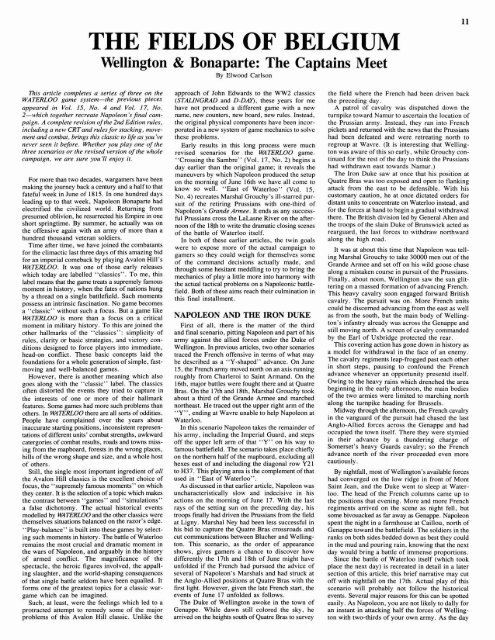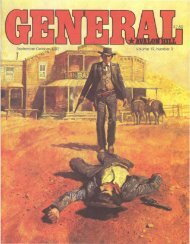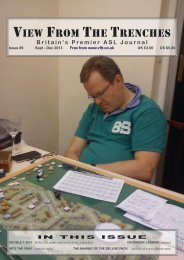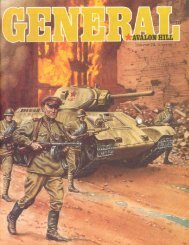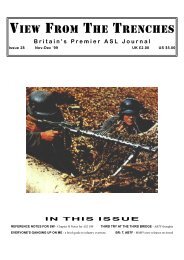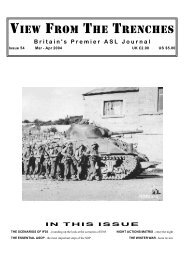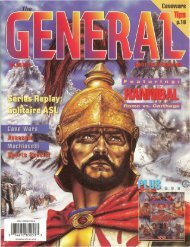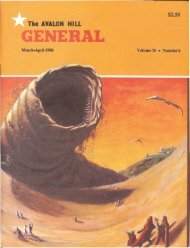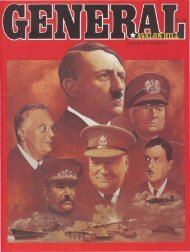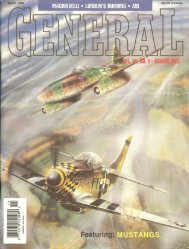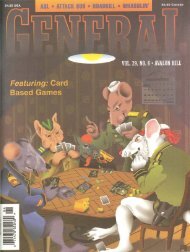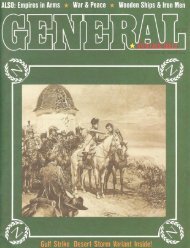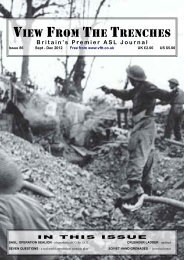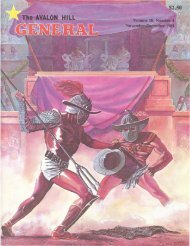18.64MB - View From The Trenches
18.64MB - View From The Trenches
18.64MB - View From The Trenches
- TAGS
- trenches
- www.vftt.co.uk
You also want an ePaper? Increase the reach of your titles
YUMPU automatically turns print PDFs into web optimized ePapers that Google loves.
THE FIELDS OF BELGIUM<br />
Wellington & Bonaparte: <strong>The</strong> Captains Meet<br />
By Elwood Carlson<br />
This article completes a series of three on the<br />
WATERLOO game system-the previous pieces<br />
appeared in Vol. 15, No. 4 and Vol. 17, No.<br />
2-which together recreate Napoleon SJnal cam-<br />
paign. A complete revision of the 2nd Edition rules,<br />
including a new CRTand rules for stacking, move-<br />
ment and combat, brings this classic to life as you've<br />
never seen it before. Whether you play one of the<br />
three scenarios or the revised version of the whole<br />
campaign, we are sure you'll enjoy it.<br />
For more than two decades, wargarners have been<br />
making the journey back a century and a half to that<br />
fateful week in June of 1815. In one hundred days<br />
leading up to that week, Napoleon Bonaparte had<br />
electrified the civilized world. Returning from<br />
presumed oblivion, he resurrected his Empire in one<br />
short springtime. By summer, he actually was on<br />
the offensive again with an army of more than a<br />
hundred thousand veteran soldiers.<br />
Time after time, we have joined the combatants<br />
for the climactic last three days of this amazing bid<br />
for an imperial comeback by playing Avalon Hill's<br />
WATERLOO. It was one of those early releases<br />
which today are labelled "classics". To me, this<br />
label means that the game treats a supremely famous<br />
moment in history, when the fates of nations hung<br />
by a thread on a single battlefield. Such moments<br />
possess an intrinsic fascination. No game becomes<br />
a "classic" without such a focus. But a game like<br />
WATERLOO is more than a focus on a critical<br />
moment in military history. To this are joined the<br />
other hallmarks of the "classics": simplicity of<br />
rules, clarity or basic strategies, and victory conditions<br />
designed to force players into immediate,<br />
head-on conflict. <strong>The</strong>se basic concepts laid the<br />
foundations for a whole generation of simple, fastmoving<br />
and well-balanced games.<br />
However, there is another meaning which also<br />
goes along with the "classic" label. <strong>The</strong> classics<br />
often distorted the events they tried to capture in<br />
the interests of one or more of their hallmark<br />
features. Some games had more such problems than<br />
others. In WATERLOO there are all sorts of oddities.<br />
People have complained over the years about<br />
inaccurate starting positions, inconsistent representations<br />
of different units' combat strengths, awkward<br />
catergories of combat results, roads and towns missing<br />
from the mapboard, forests in the wrong places,<br />
hills of the wrong shape and size, and a whole host<br />
of others.<br />
Still, the single most important ingredient of all<br />
the Avalon Hill classics is the excellent choice of<br />
focus, the "supremely famous moments" on which<br />
they center. It is the selection of a topic which makes<br />
the contrast between "games" and "simulations"<br />
a false dichotomy. <strong>The</strong> actual historical events<br />
modelled by WA~RU)O and the other classics were<br />
themselves situations balanced on the razor's edge.<br />
"Play-balance" is built into these games by selecting<br />
such moments in history. <strong>The</strong> battle of Waterloo<br />
remains the most crucial and dramatic moment in<br />
the wars of Napoleon, and arguably in the history<br />
of armed conflict. <strong>The</strong> magnificance of the<br />
spectacle, the heroic figures involved, the appalling<br />
slaughter, and the world-shaping consequences<br />
of that single battle seldom have been equalled. It<br />
forms one of the greatest topics for a classic wargame<br />
which can be imagined.<br />
Such, at least, were the feelings which led to a<br />
protracted attempt to remedy some of the major<br />
problems of this Avalon Hill classic. Unlike the<br />
approach of John Edwards to the WW2 classics<br />
(STALINGRAD and D-Dm, these years for me<br />
have not produced a different game with a new<br />
name, new counters, new board, new rules. Instead,<br />
the original physical components have been incor-<br />
porated in a new system of game mechanics to solve<br />
these problems.<br />
Early results in this long process were much<br />
revised scenarios for the WATERLOO game.<br />
"Crossing the Sambre" (Vol. 17, No. 2) begins a<br />
day earlier than the original game; it reveals the<br />
maneuvers by which Napoleon produced the setup<br />
on the morning of June 16th we have all come to<br />
know so well. "East of Waterloo" (Vol. 15,<br />
No. 4) recreates Marshal Grouchy's ill-starred pur-<br />
suit of the retiring Prussians with one-third of<br />
Napoleon's Grande Armee. It ends as any success-<br />
ful Prussians cross the LaLasne River on the after-<br />
noon of the 18th to write the dramatic closing scenes<br />
of the battle of Waterloo itself.<br />
In both of these earlier articles, the twin goals<br />
were to expose more of the actual campaign to<br />
gamers so they could weigh for themselves some<br />
of the command decisions actually made, and<br />
through some hesitant meddling to try to bring the<br />
mechanics of play a little more into harmony with<br />
the actual tactical problems on a Napoleonic battle-<br />
field. Both of these aims reach their culmination in<br />
this final installment.<br />
NAPOLEONANDTHEIRONDUKE<br />
First of all, there is the matter of the third<br />
and final scenario, pitting Napoleon and part of his<br />
army against the allied forces under the Duke of<br />
Wellington. In previous articles, two other scenarios<br />
traced the French offensive in terms of what may<br />
be described as a "Y-shaped" advance. On June<br />
15, the French army moved north on an axis running<br />
roughly from Charleroi to Saint Armand. On the<br />
16th, major battles were fought there and at Quatre<br />
Bras. On the 17th and 18th, Marshal Grouchy took<br />
about a third of the Grande Armee and marched<br />
northeast. He traced out the upper right arm of the<br />
"Y", ending at Wavre unable to help Napoleon at<br />
Waterloo.<br />
In this scenario Napoleon takes the remainder of<br />
his army, including the Imperial Guard, and steps<br />
off the upper left arm of that "Y" on his way to<br />
famous battlefield. <strong>The</strong> scenario takes place chiefly<br />
on the northern half of the mapboard, excluding all<br />
hexes east of and including the diagonal row Y2 1<br />
to H37. This playing area is the complement of that<br />
used in "East of Waterloo".<br />
As discussed in that earlier article, Napoleon was<br />
uncharacteristically slow and indecisive in his<br />
actions on the morning of June 17. With the last<br />
rays of the setting sun on the preceding day, his<br />
troops finally had driven the Prussians from the field<br />
at Ligny. Marshal Ney had been less successful in<br />
his bid to capture the Quatre Bras crossroads and<br />
cut communications between Blucher and Welling-<br />
ton. This scenario, as the order of appearance<br />
shows, gives gamers a chance to discover how<br />
differently the 17th and 18th of June might have<br />
unfolded if the French had pursued the advice of<br />
several of Napoleon's Marshals and had struck at<br />
the Anglo-Allied positions at Quatre Bras with the<br />
first light. However, given the late French start, the<br />
events of June 17 unfolded as follows.<br />
<strong>The</strong> Duke of Wellington awoke in the town of<br />
Genappe. While dawn still colored the sky, he<br />
arrived on the heights south of Quatre Bras to survey<br />
the field where the French had been driven back<br />
the preceding day.<br />
A patrol of cavalry was dispatched down the<br />
turnpike toward Namur to ascertain the location of<br />
the Prussian army. Instead, they ran into French<br />
pickets and returned with the news that the Prussians<br />
had been defeated and were retreating north to<br />
regroup at Wavre. (It is interesting that Wellington<br />
was aware of this so early, while Grouchy continued<br />
for the rest of the day to think the Prussians<br />
had withdrawn east towards Namur.)<br />
<strong>The</strong> Iron Duke saw at once that his position at<br />
Quatre Bras was too exposed and open to flanking<br />
attack from the east to be defensible. With his<br />
customary caution, he at once dictated orders for<br />
distant units to concentrate on Waterloo instead, and<br />
for the forces at hand to begin a gradual withdrawal<br />
there. <strong>The</strong> British division led by General Alten and<br />
the troops of the slain Duke of Brunswick acted as<br />
rearguard, the last forces to withdraw northward<br />
along the high road.<br />
It was at about this time that Napoleon was telling<br />
Marshal Grouchy to take 30000 men out of the<br />
Grande Armee and set off on his wild goose chase<br />
along a mistaken course in pursuit of the Prussians.<br />
Finally, about noon, Wellington saw the sun glittering<br />
on a massed formation of advancing French.<br />
This heavy cavalry soon engaged forward British<br />
cavalry. <strong>The</strong> pursuit was on. More French units<br />
could be discerned advancing from the east as well<br />
as from the south, but the main body of Wellington's<br />
infantry already was across the Genappe and<br />
still moving north. A screen of cavalry commanded<br />
by the Earl of Uxbridge protected the rear.<br />
This covering action has gone down in history as<br />
a model for withdrawal in the face of an enemy.<br />
<strong>The</strong> cavalry regiments leap-frogged past each other<br />
in short steps, pausing to confound the French<br />
advance whenever an opportunity presentd itself.<br />
Owing to the heavy rains which drenched the area<br />
beginning in the early afternoon, the main bodies<br />
of the two armies were limited to marching north<br />
'along the turnpike heading for Brussels.<br />
Midway through the afternoon, the French cavalry<br />
in the vanguard of the pursuit had chased the last<br />
Anglo-Allied forces across the Genappe and had<br />
occupied the town itself. <strong>The</strong>re they were stymied<br />
in their advance by a thundering charge of<br />
Somerset's heavy Guards cavalry; so the French<br />
advance north of the river proceeded even more<br />
cautiously.<br />
By nightfall, most of Wellington's available forces<br />
had converged on the low ridge in front of Mont<br />
Saint Jean, and the Duke went to sleep at Waterloo.<br />
<strong>The</strong> head of the French columns came up to<br />
the positions that evening. More and more French<br />
regiments arrived on the scene as night fell, but<br />
some bivouacked as far away as Genappe. Napoleon<br />
spent the night in a farmhouse at Caillou, north of<br />
Genappe toward the battlefield. <strong>The</strong> soldiers in the<br />
ranks on both sides bedded down as best they could<br />
in the mud and pouring rain, knowing that the next<br />
day would bring a battle of immense proportions.<br />
Since the battle of Waterloo itself (which took<br />
place the next day) is recreated in detail in a later<br />
section of this article, this brief narrative may cut<br />
off with nightfall on the 17th. Actual play of this<br />
scenario will probably not follow the historical<br />
events. Several major reasons for this can be spotted<br />
easily. As Napoleon, you are not likely to dally for<br />
an instant in attacking half the forces of Wellington<br />
with two-thirds of your own army. As the day


